Jess Graham looks to mountain biking and snowboarding to inspire her artwork – both as a graphic designer for Alchemist Brewing in Stowe, Vermont and in her home studio. Whether she’s embarking on powder or dirt missions or applying her creativity through acrylic paints and sketching, Graham is always thinking about her lines. Here Graham speaks to how she conveys movement in her pieces and how she came to work for one of the most well known breweries in her home state.
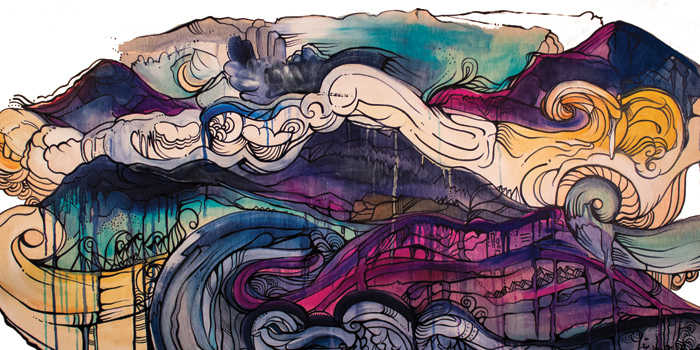
Image Title: Inversion
Backcountry Magazine: What’s your art background?
Jess Graham: I grew up in Morrisville, Vermont on a dairy farm. My folks are both from Long Island, so we often made trips down there to visit my grandparents. I got to spend a lot of time in New York City and take in a wide range of art, from graffiti to museums. I had exposure to a lot of creative outlets. At home, instead of getting uptight about me drawing all over the walls, my parents just put up newsprint.
I went to boarding school when I was 14. It was hard to be away from home, but it was great exposure to tons of people, different cultures and more rigorous academic training. When I was a freshman, one of my teachers noticed that I wasn’t signed up for the second semester of art. She sought me out and said, “Why aren’t you signed up for art next semester?” I wasn’t sure I could fit it in my schedule, but she said, “You have to come and take art again.” After that I always pursued art.
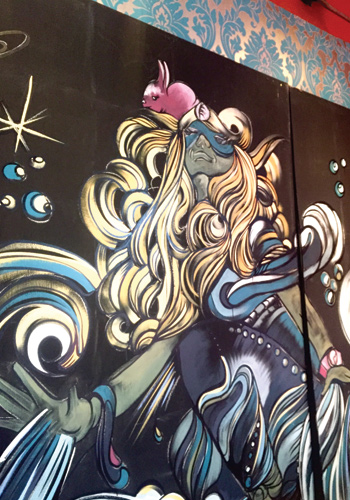
Image Title: Arts Riot mural
I got really serious about keeping an art journal when I started college. That kept me grounded whenever I traveled. It was a constant that I could use to get back to a place that I understood. It helped me get better at drawing; I was never the best artist in my class.
I lived in New York City for five years. Every year I had a little show in some sort of left wing establishment. It felt cool and radical when I was in my early twenties. I sketched a lot and got into live painting.
It became pretty clear after about four years that I was ready to leave the city. After getting mugged a couple times in my neighborhood, I started riding this hacked together fixed gear bicycle because I was afraid to walk anywhere. I started riding more and more and found that I was spending every free moment on my bike in the park. On the weekends I would do these super fun rides all through the industrial zones of New York, or down to Coney Island or Jacob Riis Park. Eventually, I realized I wasn’t doing the city thing anymore; I was just seeking refuge in nature.
That’s the thing about being an artist and an outdoor athlete—you love the city for the concentration of humanity the culture and beauty that everyone can bring, but then you crave the outdoors and being in the trees. My eyes got thirsty for green. That’s how I ended up back in Vermont.
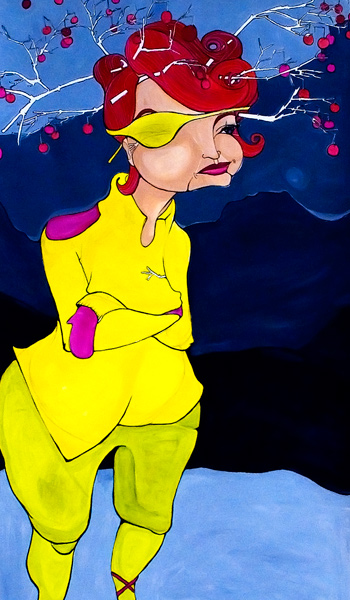
Image Title: Captain Crabapple
BCM: How did you come to work for The Alchemist (the wizards behind the infamous beer, Heady Topper)?
JG: For maybe 10 years I did my own work as a painter. During that time, I waited tables at The Alchemist—the brewpub in Waterbury, Vt. But then I blew my knee out, and my whole work life flashed in front of my eyes. I thought, “Oh my god, everything I do for a living involves being incredibly active: teaching snowboarding, coaching mountain biking, waiting tables. Maybe I should pursue something where I can sit down.” After that I got much more serious about pursuing my art.
The owners of The Alchemist discovered I was a painter, so they asked me to do some work for them at the brewery. It slowly evolved from there. It’s awesome for me to get the opportunity, and they’re great people to work for.
BCM: What are some of the most exciting or interesting projects you’ve done for The Alchemist, or in general?
JG: My whole job at The Alchemist has been a learning process. I started out knowing a little bit about graphic design, but I’ve taught myself a ton through experience—just trying things out, not always succeeding and getting helpful feedback. It’s been exciting to see my growth as a graphic designer over the years. I have a better understanding of the process between the formation of an idea, the design and the actual output. It’s such a practical and applied way of doing art, and I enjoy that—the puzzle of it.
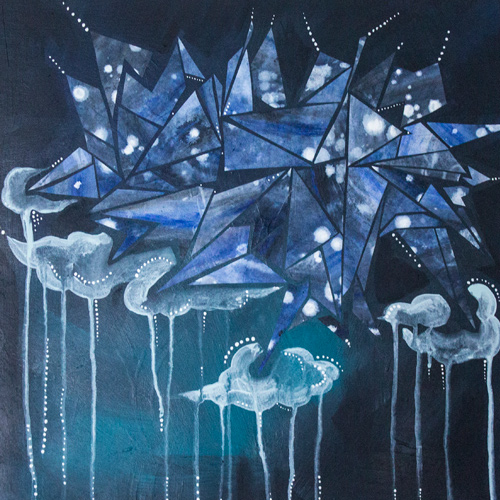
Image Title: Mountain Collage
What I really love to do is paint. When we opened the new brewery in Stowe, I got to paint the bathroom doors, a mural on the half walls and the silo outside. I loved getting to paint the silo. That was awesome; it’s such a big, visible project.
BCM: What mediums do you use for your own work?
JG: Mostly acrylic or latex paint, but sometimes I’ll cover something in spray paint and do line work over it. I still haven’t really learned how to use spray paint well; it’s such a craft. When I’m doing my own work, like the drippy work in my mountain inversion pieces, I blend colors with a lot of water. With acrylic paints, I can use a lot of water and glazing medium. I always do a lot of line work on top, probably from my formative sketching days in New York. I love line work, because I think it’s the best way I know to give my work definition and energy.
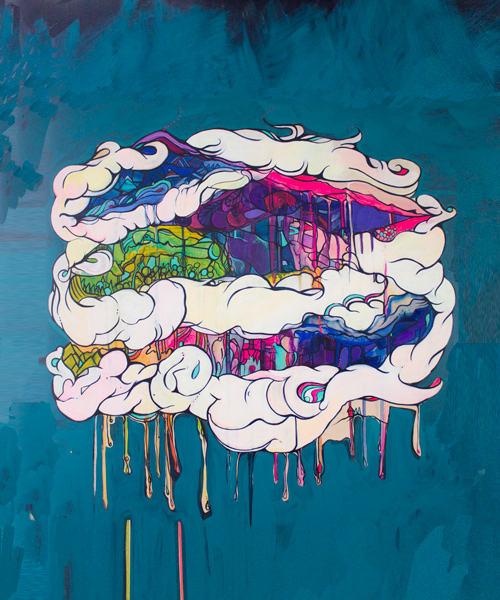
Image Title: Mountain Inversion Cloud
BCM: How has living in Vermont shaped your art?
JG: Where I live is where I’m most influenced. I live in the Lamoille River Valley; we have the Green Mountains on one side and the Worcester Range on the other. In the summer I’m not as focused on or as drawn to the mountains, because I mountain bike at lower elevations. It’s so cool to see how the mountains start to take on their own shape again as winter comes into its own. To me, the mountains are almost flat in the summer, but in the winter they become 3D.
I think everyone has their own way of seeing the world. To me, I see the world through colors, shapes and light; the world makes sense to me in that way. Every morning when I walk my dog I experience a different bird song, the progression of wildflowers or the different types and sounds of snow. Being up at sunrise on a sunny day, which is rare here, I get to see the blues, pinks, reds and purples. But also on days when it’s snowing, the whole world looks like it’s in black and white; even the evergreen trees are almost black. It’s awesome that we get to experience and appreciate that.
I’m really inspired by artists who are also athletes, because there’s a movement or energy in their work that I get. For some people the landscape looks like it’s just sitting there, but to someone who recreates or engages with the landscape it looks more alive. The way I see lines while recreating may have something to do with the fact that I’m an artist. There is a connection between the lines I make on my snowboard or mountain bike that translate to my work; the curves are in my body.
—
To view more of Graham’s work, visit jessgrahamstudio.com











Related posts:
Skintrack Sketches: John Fellows carves a place for his recreation-inspired artwork
Skintrack Sketches: Artist Jill Pelto documents climate change through watercolor
Skintrack Sketches: ACMG guide Aaron Enns zooms in on geometry to paint a bigger picture
Skintrack Sketches: Artist Lindsay Dew counts on memory to create mountainscapes